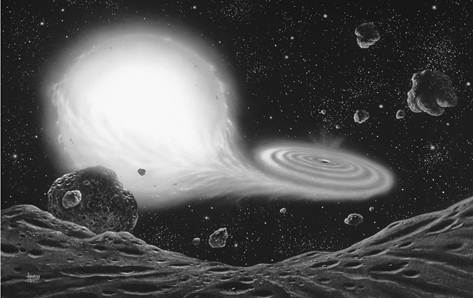


 الفيزياء الكلاسيكية
الفيزياء الكلاسيكية
 الكهربائية والمغناطيسية
الكهربائية والمغناطيسية
 علم البصريات
علم البصريات
 الفيزياء الحديثة
الفيزياء الحديثة
 النظرية النسبية
النظرية النسبية
 الفيزياء النووية
الفيزياء النووية
 فيزياء الحالة الصلبة
فيزياء الحالة الصلبة
 الليزر
الليزر
 علم الفلك
علم الفلك
 المجموعة الشمسية
المجموعة الشمسية
 الطاقة البديلة
الطاقة البديلة
 الفيزياء والعلوم الأخرى
الفيزياء والعلوم الأخرى
 مواضيع عامة في الفيزياء
مواضيع عامة في الفيزياء|
Read More
Date: 23-12-2015
Date: 16-12-2015
Date: 29-1-2017
|
A Black Hole’s Presence Revealed
It soon became clear to astronomers that Sco X-1 and many similar strong X-ray sources, including the pulsar in the Crab Nebula, are neutron stars. And they were able to develop a model to explain how neutron stars that are part of binary star systems can emit strong bursts of X rays. John Gribbin explains that in a binary star system, the two objects, one a normal star and the other a small superdense neutron star, are
orbiting each other, locked in a mutual gravitational embrace. . . . Gas from the atmosphere of the large star will be torn away from it by tidal effects and attracted to the small star. As the gas spirals down onto the small star, it will form a swirling disk of material, generating heat within the disk itself. . . . The small, dense star is surrounded by very hot gas, or plasma, which radiates at X-ray wavelengths . . . and is constantly being renewed by gas falling in from the larger star.
The fact that these strong X-ray sources are neutron stars indicated to astronomers that large bursts of X rays are often associated with superdense cosmic bodies. Considering this, at least a few scientists could not help but suspect that another kind of superdense object the then hypothetical black hole might somehow reveal its presence by producing X rays. And indeed, one strong X-ray source first detected in the 1960s did seem to be a promising black hole candidate. Located in the constellation of Cygnus, the swan, it became known as Cygnus X-l, or Cyg X-1 for short.
Like Sco X-l, Cyg X-1 is part of a binary star system. But unlike the case of Sco X-l, the object orbiting the normal star in the Cyg X-1 system emits no visible light at all. Also, the bursts of X rays coming from Cyg X-1 occur at astonishing rates as high as a thousand or more per second. This tells astronomers that the invisible object must be extremely small and compact. According to Friedman (who in the 1960s boldly predicted that Sco X-1 was a neutron star):
A star cannot change its brightness in less time than it takes light [or X rays and other forms of electromagnetic radiation] to cross its diameter. . . . Thus, when Cyg X-1 exhibited millisecond bursts, it meant that the X-ray-emitting region could be no more than 300 kilometers [about 186 miles] across.
Another reason why scientists suspected that the Cyg X-1 object is a black hole is that it is tremendously massive for such a tiny body. The normal star in the system is a giant of about thirty solar masses. Astronomers were able to work out its orbital characteristics and from this calculate the mass of the invisible companion. They found it to be nine solar masses, too massive to be a neutron star, which strongly suggested that the Cyg X-1 system harbors a stellar black hole.
It is now clear that Cyg X-1 emits such strong bursts of X rays through a combination of the black

An artist’s view of what the Cygnus X-1 system may look like. Matter from the giant star is drawn away into the black hole’s accretion disk.
hole’s powerful gravity and its close proximity to the larger companion star. The black hole is a bit closer to the other star than the planet Mercury is to the Sun. (Mercury lies about 36 million miles from the Sun.) Such extremely close quarters for these massive bodies allow the black hole’s gravity to draw gases from the outer layers of the companion. As these gases spiral in toward the denser object, they form a huge, rapidly spinning, and very hot accretion disk around the outside of the hole’s event horizon. Slowly but surely, some of the gases are pulled right up to the horizon, where the hole’s immense gravity tears the gases’ atoms apart. This extremely violent process releases strong bursts of X rays only an instant before the stream of matter disappears forever beyond the event horizon. In the minutes, days, and years that follow, the X rays emitted in this manner travel outward, eventually reaching Earth and showing scientists the position of the black hole.



|
|
|
|
بـ3 خطوات بسيطة.. كيف تحقق الجسم المثالي؟
|
|
|
|
|
|
|
دماغك يكشف أسرارك..علماء يتنبأون بمفاجآتك قبل أن تشعر بها!
|
|
|
|
|
|
|
العتبة العباسية المقدسة تواصل إقامة مجالس العزاء بذكرى شهادة الإمام الكاظم (عليه السلام)
|
|
|